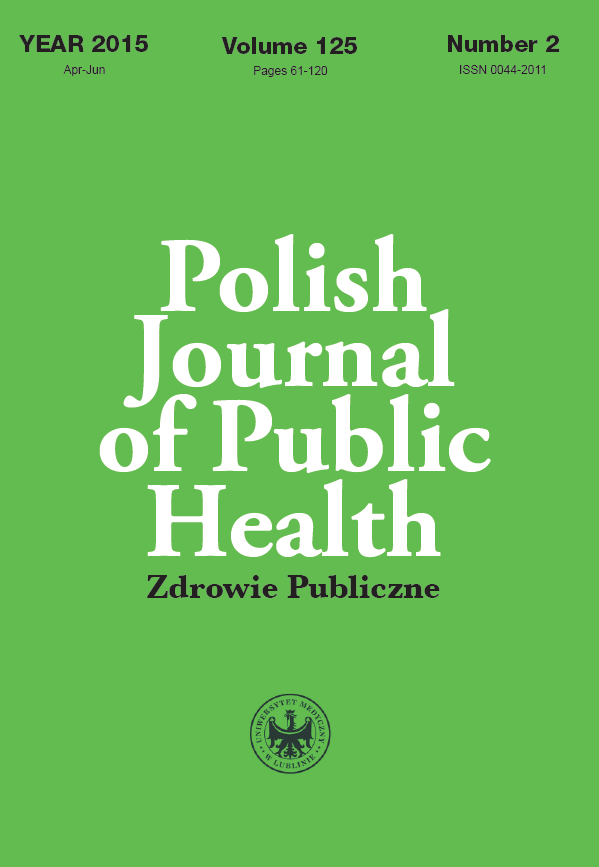Incidence of acute allergic reactions to contrast medium following CT examination on the basis of analysis of medical record data – preliminary report
DOI:
https://doi.org/10.1515/pjph-2015-0034Keywords:
contrast medium, allergic reactions, medical record, computed tomographyAbstract
Introduction. A contrast-enhanced CT examination can have negative health implications. It can spark both allergic and other adverse reactions.
Aim. The study aimed at analyzing the incidence of acute allergic reactions to Ultravist 370, used as a contrast medium in a CT examination.
Material and methods. The analysis of medical records that comprised 12295 patients who had undergone a CT examination. Women accounted for 50.7% of the study participants. Mean age of the patients was 62 years (min. 15; max. 92, SD=10.123). In the study, 6219 patients were examined without using a contrast medium and 6076 individuals underwent a contrast-enhanced CT examination. In the further analysis, Group 1 comprised of 15 patients from the contrast-enhanced CT examination group who confirmed being allergic to a contrast medium after the CT examination and Group 2 comprised 49 persons who had reported being allergic to iodine before the CT examination.
Results. 15 patients (8 women and 7 men) developed an allergy to Ultravist 370 (contrast medium). An acute allergic reaction was most likely to happen in two groups of patients: between 31-40 and 51-60 years. Some 12 out of 15 patients had no contraindications for taking an iodine-based contrast medium. The most frequent allergic reactions to Ultravist 370 were rash and urticaria (15 patients). Five patients out of those who experienced adverse reactions reported two symptoms of allergy each while other patients reported one symptom only. Patients with mild symptoms of acute reaction to a contrast medium (15 patients) received pharmacotherapy recommended by a radiologist. Some 13 individuals received Solu-Medrol intravenously and 2 patients received Solu-Medrol intravenously and Fenicort intramuscularly.
Conclusions. 1. Using Ultravist 370 in patients is safe, since there is very low risk of adverse side effects caused by the application of this contrast medium. 2. In the present study, age, gender, and risk factors contributed to the development of acute allergic reactions. However, due to the small size of the study group, it is obvious that issues like the incidence of symptoms of discomfort or intolerance of the drug need further research. 3. Owing to the fact that essential biochemical tests had not been performed on a large group of patients, doctors referring patients to a CT examination should take care of their own safety by properly preparing themselves for this procedure. 4. It seems essential to develop and implement regular trainings for CT laboratory staff with reference to the following issues: the incidence and nature of acute adverse reactions to non-ionic contrast medium (Ultravist 370), as well as the procedures for dealing with side effects.
References
1. Kopp AF, Mortelle KJ. Częstość występowania ostrych reakcji po lo¬promidzie: badanie obserwacyjne 74 717 chorych po wprowadzeniu preparatu na rynek. Acta Radiol. 2008;49(8):45-9.
2. Wysocka A, Wysocki H. Wybrane działania niepożądane środków kon¬trastowych stosowanych u chorych poddanych przezskórnym inter¬wencjom na naczyniach wieńcowych, Now Lek. 2007;76(2):121-5.
3. Koziński M, Kubica MJ. Wpływ rodzaju i objętości wybranych nie¬jonowych środków cieniujących na odpowiedź zapalną u pacjentów poddanych angioplastyce wieńcowej. Folia Cardiol. 2005;11(12):740-51.
4. Pruszyński B. Radiologia. Diagnostyka Obrazowa Rtg, TK, USG, MR i medycyna nuklearna. Warszawa: Wyd. PZWL; 2003. p. 15-20, 51-3, 66-8, 77-80, 90-2.
5. Pruszyński B. Diagnostyka Obrazowa. Podstawy teoretyczne i metody¬ka badań. Warszawa: PZWL; 2000. p. 18, 22-6, 66-9, 79, 143-6, 408-17.
6. Prokop M, Galanski M. Spiralna i wielorzędowa tomografia komputer¬owa człowieka. Warszawa: Medipage; 2007. p. 2-3, 9-11, 18-20, 86-90, 102.
7. Baert AL, Knauth M. Medical Radiology. Diagnostic Imaging. Berlin: Contrast Media, Springer-Werlag; 2006/2009.
8. Morcos SK. Acuta serious and fatal reactions to contrast media: our cur¬rent understanding; BJR. 2005;78:686-93.
9. Caro JJ, Trindade E, McGregor M. The risks of heath and of severe nonfatal reactions with high – vs low osmo-lalit contrast media: a meta-analysis. Am J Roentgenol. 1991;156:825-32.
10. Brant WE, Helms C. Podstawy diagnostyki radiologicznej. Warszawa: Medipage; 2006. p. 9-11, 48, 26-8.
11. Bush WH, Swanson DP.Acute reactions to intravascular contrast media: types, risk factors, recognition, and specific treatment. Am J Roentgenol. 1991;157:1153-61.
12. Lasser EC, Berry C. Pretreatment with corticosteroids to prevent adverse reaction to monionic contrast media. Am J Roentgenol. 2012;98(5):189-96.
13. Lasser EC. Contrast reactions. Eked data from contrastreaction surveys. Invest Radiol. 1990;25(Suppl. 1):145.
14. Lasser EC. contrast reaction [http://www.google.pl/search?g=lasser+-+contrast +reaction]
15. Shehadi WH. Contrast media adverse reactins: occurrence, reccurence, and distribution patterns. Radiol. 1982;143:117-9.
16. Dahlstrom K, Shaw DD, Clauss W, et al. Summary of U.S. and Euro¬pean intravascular experience with iohexol based on the clinical trial program. Invest Radiol. 1985;20(Suppl. 1):117-21.
17. Miles SG, Rasmussen JF, Litwiller T, et al. Safe use of an intravenous power injector for CT; experience and protocol. Radiol. 1998;209:411-6.
18. Jacobs JE, Birnbaum BA, Longlotz CP. Contrast media reactions and extravasation; relationship to intravenous injection rates. Radiol. 1998;209:411-6.
19. Petersein J, Peters CR, Wolf M, Hamm B. Results of the safety and ef¬ficacy of iobitridol in more than 61,000 patients. Eur Radiol. 2003;13: 2006-11.
20. Katayama H, Yamaguchi K, Tozuka T, et al. Adverse reactions to ionic and nonionic contrast media. A reports from the Japanese Committee on the Safety of Contrast Media. Radiol. 1990;175:621-8.
21. Pruszyński B. Wskazania do badań obrazowych. Warszawa: Wydawnict¬wo Lekarskie PZWL; 2011. p.88-91, 186-7, 190-5.
22. Bettman MA. Freguenthyasked guesstions iodinated contrast agents. Radiographics. 2004;24(Suppl. 1):310.
23. Mortele KJ, Oliva MR, Ondatequi S, et al. Universal USC of nonionic iodinated kontrast medium for CT: evaluation of safety in a large urban teaching hospital. Am J Rpentgenol. 2005;184:314.
24. Narita S, Goldblum RM, Watson CS, et al. Environmental estrogens induce mast cell degranulation and enhance IgE-mediated release of al¬lergic mediators. Environ Health Perspect. 2007;115:485-2.
Downloads
Published
Issue
Section
License
Copyright (c) 2015 Polish Journal of Public Health

This work is licensed under a Creative Commons Attribution-NonCommercial-NoDerivatives 3.0 Unported License.


